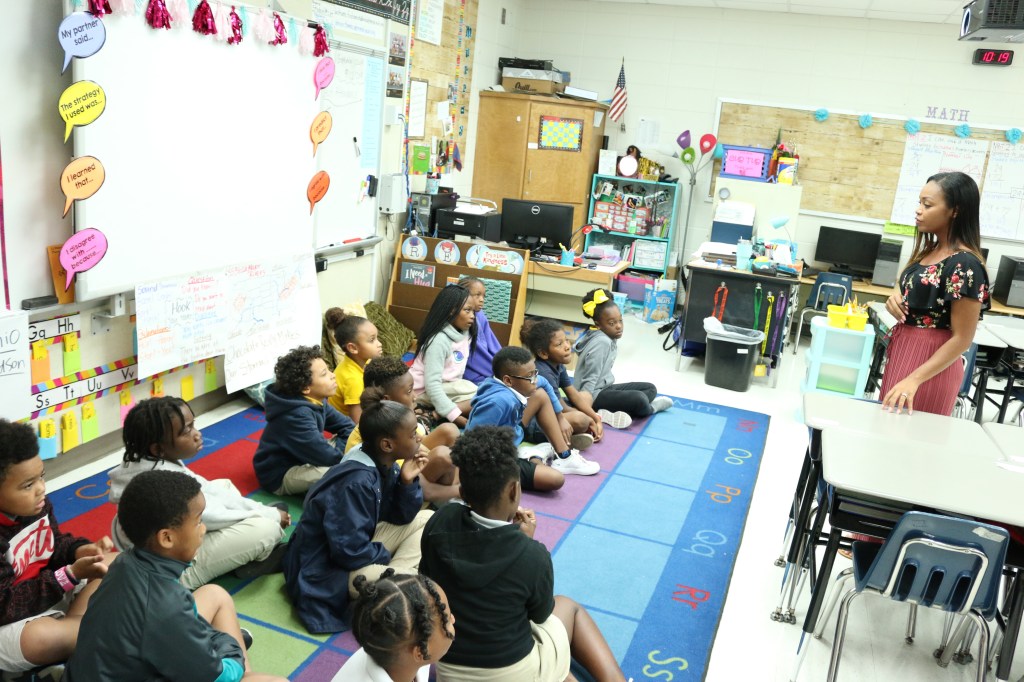Experts say pandemic exposes education inequalities
Published 10:00 am Friday, April 24, 2020

- In this Valdosta Daily Times file photo, Melvina Murray speaks to her class at S.L. Mason Elementary.
ATLANTA — A month of virtual learning has exposed gaps in resources that existed long before the COVID-19 outbreak, according to education officials.
State education leaders realize the shift to online classes and instruction may be harder for some schools than others.
Trending
Across rural Georgia, students search for access to the internet and many teachers struggle to provide online instruction for their students while parenting at home. Advocates say low-income and black students are at the highest risk of a delay in learning.
Gov. Brian Kemp during a press conference recognized that across the state schools and teachers “are doing the best with what they’ve got to work with.”
“The good thing is we’re learning what everyone needs now,” he said. “That’ll be something that we will be able to address and make things better in the future.”
Matt Jones, chief of staff for the state superintendent, told CNHI the state has an extremely wide spectrum of educational resources and capacities, requiring different plans of action for nearly every district.
“I think anytime you have a crisis,” Jones told CNHI, “it just magnifies inequalities that existed beforehand.”
Emphasizing resource gaps
Trending
After Kemp mandated the close of K-12 public schools through the end of the academic year, Valdosta City Schools notified parents on social media the school system would not be able to offer electronic devices for kindergarten through fifth-grade students and could not ensure “equitable” distribution of devices or internet access for all students.
The Department of Education has a prioritized list of schools which it uses to distribute electronic devices as they arrive at the department.
“This was an issue before this hit — devices and connectivity,” Jones said.
Since the switch to virtual learning, the department has distributed 2,340 electronic devices to schools through partnerships with private companies in addition to devices issued to students by schools.
But access to devices and the internet aren’t the only dividing factor — urban schools with larger staffs and increased technological capabilities can instruct large groups of students at a time, while rural areas with fewer resources turn their focus to students who may need more support than others.
“You have some of the larger, metro districts who are able to do most all their teaching online and have a very robust system,” he said. “Other parts of the state — particularly in rural Georgia — it’s more prioritizing certain groups to students those at risk for not graduating or those who are behind.”
Charlotte Booker, president of the Georgia Association of Educators, said disparities are not just on a school district level, but also vary widely from student to student.
“It’s really important for school systems to remember that all students don’t have the same access,” she told CNHI. “It would be great if they would accommodate those students by providing them with access in their homes. Because I would hate it if my child, or if I didn’t have, or I couldn’t afford, or didn’t have that in my home, that somebody would provide it so that my child would not be left behind.”
A state Senate study committee on educational development of black children recommended changes earlier this year that would increase support for schools historically serving minority and low-income populations.
Georgia is one of a handful of remaining states that doesn’t supply additional funds for schools serving high numbers of low-income students. Schools in rural areas of the state often with the largest racial diversity and some of the highest poverty levels have seen no additional financial support through Georgia’s long-time funding formula.
On top of funds from the federal relief package, Georgia will soon see $105 million in emergency funds from the U.S. Department of Education for K-12 and postsecondary schools impacted by coronavirus.
Jones said the department has shared estimated allotments with districts and is preparing to get the money to them as quickly as possible.
The Southern Education Foundation in hand with other civil rights and education equity organizations, sent a letter to Kemp and State Superintendent Richard Woods Thursday, urging them to prioritize low-income families, English learners and underserved students when distributing federal funds.
Fred Jones, director of government affairs for the foundation, said in a statement to CNHI that while coronavirus is affecting everyone, low-income and black children “specifically have a harder time adjusting to distance or remote learning.”
According to the foundation, roughly 20% of African American children ages 3 to 18 years old and 21% of families earning less than $40k per year have no internet at home throughout the nation.
Jones said it is “essential” that school districts create a digital equity plan.
“Unfortunately, many low-wealth school districts will not have extra funding to ensure digital equity practices are employed,” he said. “Thus making students from low-income families less likely to receive additional services they need.”
‘Compassion over compliance’
On April 17, Woods encouraged schools, teachers and parents to avoid measuring their success against that of other districts.
“For all of us, it is tempting to look around to other districts and schools to compare what is going on to your reality,” he wrote. “No two schools or districts are alike. The capabilities and communities vary. Everyone is doing their best to make this situation work.”
Matt Jones, with the department of education, said that — unsurprisingly — when the pandemic hit and schools closed, educators across the state tried to mimic a typical eight-hour school day online, resulting in an “overload” for students and teachers.
Jones said the department stresses the learning taking place right now isn’t a full replacement to the classroom, but supplemental.
“We want to keep learning going on and learning opportunities going on, but we have to realize that we might have households that they only have one device and multiple kids have to use that device. Or you might have households where parents are sick or students have health issues as well,” he said. “I think instead of just looking at it purely from the educational end, we’ve got to look at this by all these forces that are pushing on the family right now.”
Earlier this month, the state department received a requested federal testing waiver, that did away with state testing — including Georgia Milestones EOGs and EOCs, GAA 2.0 and GKIDS – for the year. The department also sent relaxed grading and attendance guidelines for schools to follow.
Like most things, officials said, the education system will be forever changed by the pandemic.
“The COVID-19 is kind of an education reform catalyst in the sense of when we’re looking at things that we’ve always thought has been essential like high stakes testing and teacher evaluation and school accountability. I think we need to look at that and to see are those things needed,” Jones said.
Federal funds are on their way to schools through the Coronavirus Aid, Relief, and Economic Security Act. Below are estimates based on information from the Congressional Research Service, according to the State Department of Education. Final funds may vary.
- Colquitt County School District: $2,889,639.2
- Whitfield County School District: $3,276,555.895
- Dalton City School District: $1,814,540.705
- Lowndes County School District: $2,022,192.23
- Valdosta City School District: $3,429,950.07
- Baldwin County School District: $1,986,932.415
- Thomas County School District: $907,678.8
- Thomasville City School District: $1,094,391.545
- Tift County School District: $2,474,791.86





